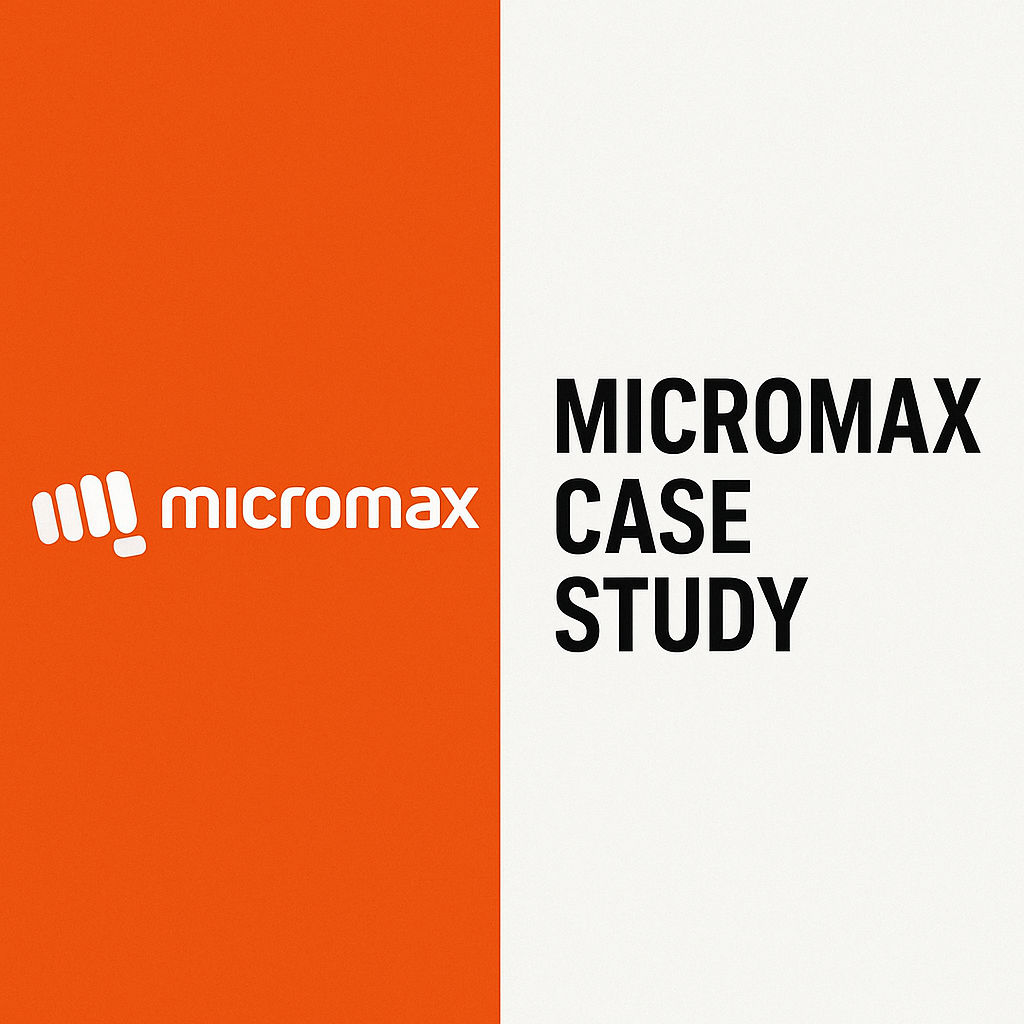
Micromax was founded by Rahul Sharma and Rohit Patel in the year 2000. The company started selling mobile phones in the year 2008. In 2014, the sales of Micromax exceeded those of Samsung.
The company lost its edge due to the entry of Chinese brands such as Oppo, Xiaomi, and Vivo.
The brand failed mainly because of three reasons
- Customers perceived the brand as a cheap Indian brand.
- The brand failed to connect emotionally with Gen Z customers.
- Lack of innovation.
Problem statement
How can Micromax reposition itself to regain the Indian market?
Objectives
- Change perception from a cheap Indian-made phone to bold and innovative phones.
- Target middle-class consumers and emotionally connect with Gen Z customers.
- Focus more on performance and pride.
Rebranding Strategy
Kotler’s 5 product levels—the customer value hierarchy
- Core benefit: In a market like India, customers always seek to buy quality products at affordable prices. The Micromax smartphone company offers the core benefit of affordable access to digital technology.
Through this, the company will be able to empower millions of people to participate in the digital economy. The users of the phone will be able to connect through social media apps, access entertainment apps and games, enhance education, and also perform digital payments.
- Basic Product: A tangible smartphone with a functional touchscreen, Android OS, good battery life, a good camera with enough storage space, and dual SIM capabilities. These features help to get a place within the competitive market of budget smartphones.
By providing these basic features, Micromax can position itself as an alternative to Chinese smartphone brands that dominate the lower price tiers.
- Expected Product: The Indian customers expect more than just functionality while purchasing a budget smartphone. They want great performance with decent cameras to take pictures and share on social media, and require a reliable battery life and fast and better after-sales service.
Brands like Xiaomi, Oppo, and Realme shaped these expectations and raised the bar in this segment. To regain trust and credibility, Micromax should ideally exceed these standard expectations.
- Augmented Product: This is the product level where Micromax can differentiate its offering compared to other brands. The brand can tap into national sentiment with a
“Made in India” narrative, engaging the pride of domestic consumers.
Unlike other competing brands, which have security concerns over data privacy and also have preloaded bloatware, Micromax can offer a safer and cleaner Android experience.
Also, the brand can use local networks for faster repairs and offer India-based customer service in local languages. These value-added features create a positive perception in the minds of Indian customers that the brand is tuned to Indian needs and cultures.
- Potential Product: This level envisions what Micromax can achieve in the future. What levels of transformation can the product undergo in the future?
The brand can transform into a complete ecosystem for price-conscious Indian customers. This includes smart TVs, Laptops, Tablets, and wearables. Partnerships with edtech companies can help provide valuable services to students and youth in rural areas.
These likely improvements could help the brand provide a forward-looking identity, positioning the brand not just as a smartphone maker but also prioritizing the data security of Indian consumers, and also as an enabler of India’s progress in digitalization.
Keller’s Brand Resonance Pyramid
Kevin Lane Keller’s Brand Resonance Pyramid provides a framework for building a strong brand through four levels: brand identity, brand meaning, brand response, and brand resonance.
The rebranding begins with brand salience, rebuilding brand awareness by promoting the brand’s “Made in India” identity through influencer marketing and digital campaigns. The aim here is to remind customers that Micromax is a brand that is specifically made for Indian customers in India.
The brand focuses on providing solid smartphone basics, that is, long battery life, good quality camera, clean Android without bloatware, and better privacy at the brand’s performance level.
Brand Imagery-wise, the brand should reposition itself as a Tech for India brand rather than an affordable smartphone. The new imagery should position the brand as Indian youth and entrepreneurs use Micromax to learn and grow.
Collaborations with Indian influencers, testimonials from new customers, and affordable price-based messaging can reinforce the Made in India appeal.
In Brand judgment, the importance is given to quality and trust. By communicating the latest advancements and by showing transparency, the brand can regain trust. Emotionally brand sparks feelings like independence, smart decision-making, and pride in a market that is crowded with foreign brands.
The brand Resonance can be achieved by launching a national initiative named “Micromax Yuva”. This will be a contest for young tech enthusiasts in local towns. The participants can register for the event with the serial number of their Micromax Smartphones and present their projects using the portal of the edtech company app the brand is collaborating.
The winners can be awarded a scholarship for their studies and early access to new devices at offer prices. The winners and participants can get featured in brand stories and social media pages of the brand, which motivates others to participate in the event.
Online forums can be utilized to keep the community active, and this also helps in promoting the brand in their circles. In this way, Micromax can turn into a symbol of national pride and help in connecting emotionally with customers.
Positioning
To Indian youth and millennials who want better-performing smartphones at an affordable price. Position Micromax as the Indian-made smartphone that is bloatware-free and provides better security compared to overpriced, under-performing imported smartphones.
Reinforce the feeling that, unlike Chinese exports, Micromax stands for India-first Innovation. Portray Micromax as the symbol of India’s tech Independence.
Rebranding Using the SB7 Framework
- Hero: Young Indian tech enthusiasts, either students or first-time smartphone users, who want a smartphone with reliable technology and security, also within their budget.
- Problem
- External: Not able to find a reliable smartphone within an affordable range.
- Internal: Tired of bloated devices from foreign brands and a lack of identity by using them.
- Philosophical: Need a smartphone made for Indian consumers because Indian consumers deserve quality technology.
- Guide: “Micromax” comes as a guide, an Indian brand that prioritizes the needs of Indian customers and proudly says, “We are in for India”.
- Plan: Provides a smartphone that is designed for the needs of Indian customers with no bloatware. Provide good quality features and better post-purchase service compared to foreign brands at affordable prices.
- Call to action: “Be a proud Indian. Choose Micromax”.
- Helps to avoid failure: No more data piracy, no more overpriced underperforming phones, no more bad post-purchase service.
- Ends in Success: Own a trustworthy smartphone with updated technology. Proud to support the Indian brand. Confident that they have made a smart choice.
One Liner: “Micromax provides you with the best-performing smartphone in the segment with high-quality security at an affordable price. It’s time to own a smartphone that reflects your pride and your nation – Choose Micromax.”
Advertisement script: Using the insights from Ogilvy.
Scene 1: A rural area where a YouTuber uses Micromax to shoot high-quality reels and upload. Showing the camera quality, storage, and battery life
Scene 2: A student in a rural area using a Micromax to download files and learn. Showcasing the performance, storage, and battery life
Scene 3: A delivery boy using a Micromax to access the GPS to deliver to a far location.
Scene 4: A customer finishes payment with Micromax. Prompt and smooth.
Scene 5: Everyone finishes their task with a beautiful smile.
Voice Over: Choose a smartphone that is designed for you. “Apna desh ka phone”
Voice over and Tagline: Micromax, “Made for India.Powered by you”
Point of Difference and Point of Parity.
| Point of Parity | Point of Difference |
| Android OS | Clean and Bloatware-free |
| Affordable price | Proudly “Made in India” |
| Standard features: display and camera | Customer support in all local languages in India |
Neuroscience strategy
- Use testimonials of real Indian users(students, youtubers,workers)
- Emotional taglines in Hindi: “Apna desh ka phone”.
- More emphasis on Indian-made to reinforce trust.
- Use tri-colors. Use Regional themes in wallpapers.
- Reinforce the feeling that owning a Micromax highlights pride and independence. Not a slave to overpriced, under-performing foreign brands.
Conclusion
Micromax doesn’t want to cut down prices to beat the competition from imported phones. Micromax can be featured as the Icon of India’s technology by tapping into the emotion that Micromax is the symbol of India’s tech Independence.
